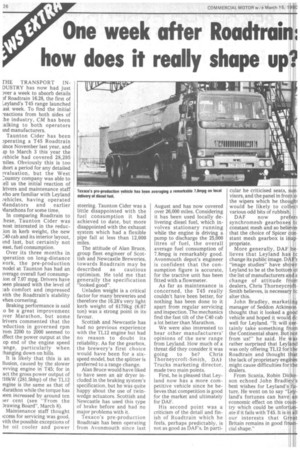One week after Roadtrain: how does it really shape up!
Page 28

If you've noticed an error in this article please click here to report it so we can fix it.
THE TRANSPORT INDUSTRY has now had just aver a week to absorb details Roadtrain 16.28, the first of Leyland's T45 range launched ast week. To find the initial 7eactions from both sides of he industry, CM has been ,alking to both operators tnd manufacturers.
Taunton Cider has been aperating a T45 Roadtrain ;ince November last year, and ip to March 3 this year the rehicle had covered 28,295 miles. Obviously this is too ;hort a period for any detailed waluation, but the West 2ountry company was able to :ell us the initial reaction of Myers and maintenance staff who are familiar with Leyland ,Tehicles, having operated Vlandators and earlier Vlarathons for some time.
In comparing Roadtrain to ,hese, Taunton Cider was nost interested in the reducion in kerb weight, the new :40 cab and its interior layout, Ind last, but certainly not east, fuel consumption.
Over its three months in operation on long-distance work, the pre-production nodel at Taunton has had an tverage overall fuel consumpion of 7.07 mpg. Drivers have )een pleased with the level of ;ab comfort and impressed with the Roadtrain's stability when cqrnering.
Brakhig performance is said .o be al great improvement wer Marathon, but some !rivers commented that the .eduction in governed rpm rom 2200 to 2000 seemed to iffect the power output at the op end of the engine speed ange, particularly when ;hanging down on hills.
It is likely that this is an Ilusion, caused by the slower evving engine in T45; for in act the gross power output of !10kW (281.5bhp) of the TL12 ingine is the same as that of Vlarathon while the torque has )een increased by around ten ier cent (see "From the )rawing Board", March 8).
Maintenance staff thought iccess for servicing was good, vith the possible exceptions of he oil cooler and power steering. Taunton Cider was a little disappointed with the fuel consumption it had achieved to date, but more disappointed with the exhaust system which had a flexible pipe fail at less than 12,000 miles.
The attitude of Alan Bruce, group fleet engineer of Scottish and Newcastle Breweries, towards Roadtrain may be described as cautious optimism. He told me that generally the specification "looked good".
Unladen weight is a critical factor for many breweries and therefore the 16.28's very light kerb weight of 6170kg (6.07 ton) was a strong point in its favour.
Scottish and Newcastle has had no previous experience with the TL12 engine but had no reason to doubt its reliability. As for the gearbox, the brewery's first choice would have been for a sixspeed model, but the splitter is preferred to a range change.
Alan Bruce would have liked to have seen an air dryer included in the braking system's specification, but he was quite happy about the use of twinwedge actuators. Scottish and Newcastle has used this type of brake before and had no major problems with it.
Texaco's pre-production Roadtrain has been operating from Avonmouth since last August and has now covered over 26,000 miles. Considering it has been used locally delivering diesel fuel, which involves stationary running while the engine is driving a pump to discharge the 25,000 litres of fuel, the overall average fuel consumption of 7.8mpg is remarkably good. Avonmouth depot's engineer is confident that the consumption figure is accurate, for the tractive unit has been • fitted with a flowrneter.
As far as maintenance is concerned, the T45 really couldn't have been better, for nothing has been done to it apart from regular servicing and inspection. The mechanics find the fast tilt of the C40 cab a lot better than Marathon.
We were also interested to hear other manufacturers' opinions of the new range from Leyland. How much of a threat did they consider it was going to be? Chris Thorneycroft-Smith, DALTrucks marketing director, made two main points.
First, he is pleased that Leyland now has a more competitive vehicle since he believes that competition is good for the market and ultimately for DAF.
His second point was a criticism of the detail and finish of Roadtrain which he feels, perhaps predictably, is not as good as DAF's. In parti cular he criticised seats, sun visors, and the panel in front o' the wipers which he thoughi would be likely to colleci various odd bits of rubbish.
DAF now prefers synchromesh gearboxes tc constant mesh and so believe, that the choice of Spicer con stant mesh gearbox is inap. propriate.
More generally, DAF believes that Leyland has tc change its public image. DAF'. "image studies" have showr Leyland to be at the bottom 01 the list of manufacturers and a change of attitude from dealers, Chris ThorneycroftSmith believes, is necessary tc alter this.
John Bradley, marketing manager of Seddon Atkinson thought that it looked a good vehicle and hoped it would dc well for Leyland. "It will certainly take something from the Continental share. But not from us!" he said. He was rather surprised that Leyland was only offering TL12 for the Roadtrain and thought that the lack of proprietary engines might cause difficulties for the dealers.
From Scania, Robin Dickeson echoed John Bradley's best wishes for Leyland's future. He went on to say "Leyland's fortunes can have an economic effect on this country which could be unfortunate if it fails with T45. It is in all our interests that Great Britain remains in good financial shape."
































































































































